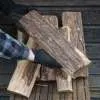Maple firewood burn qualities
1. Heat output
Heat output is an important consideration when you evaluate firewood. It needs to give off decent warmth, whether you’re at home or sitting around a campfire.
The heat provided by maple varies depending on its density. In general, the harder the wood, the higher the heat.
- Red maple is one of the softer varieties, which outputs 18.7 million BTUs per cord.
- A popular tree in the United States, the silver maple, offers similar heat of 18.0 million BTUs.
- Bigleaf maples give off 22.7 million BTUs, which is quite impressive. It is much higher than buckeye, pine, or spruce.
- The sugar maple provides 24.0 million BTUs per cord, thanks to its high density. That’s similar to white ash and red oak, which are both respected firewoods.
If you live in a very cold climate and don’t have a dense type of maple, you may want to combine it with another hotter-burning wood. Keep in mind there are many factors to consider – if your home is well insulated, then any maple will still do the job. You could also use soft maple in the shoulder seasons when lots of heat isn’t required.
Check out the following table comparing the heat output of maple to various other common types of firewood.
| Wood Variety | Heat per Cord (Million BTUS) |
| Basswood | 13.8 |
| White fir | 14.6 |
| Catalpa | 16.4 |
| Alder | 17.5 |
| Red maple (soft maple) | 18.7 |
| Silver maple | 19.0 |
| Bigleaf maple | 22.7 |
| Sugar maple (hard maple) | 24.0 |
| White ash | 24.2 |
| Beech | 27.5 |
| White oak | 29.1 |
2. Smoke
Smoky firewood isn’t ideal if you’re burning it indoors on an open fire. No one wants red, sore eyes from too much smoke floating through the house.
Seasoned maple burns clean, giving off very little smoke. Whether you’re relaxing in the comfort of your own home or sitting huddled around a campfire, smoke shouldn’t be an issue.
Although most maple firewood won’t produce smoke, sugar maple is known to get a bit smoky. If you’re after quality wood without smoke, hickory and oak are both good options.
Firewood should be properly seasoned before burning it. Green wood from the maple tree is high in water content and will billow out smoke if it’s tossed into the fire.
Unseasoned maple is also much less efficient for burning. The fire uses all its energy to evaporate water rather than providing heat.
If you’re heading out camping, be sure to check out our advice on the best firewood for campfires.
3. Ease of splitting
Softer varieties of maple are easy to split. You’re best to process the wood while it’s green, thanks to the moisture content. Once maple dries out, it hardens and becomes less yielding.
You can make splitting the wood easier by investing in a splitting axe or maul that’s right for the job. If you’re struggling to split the wood, look for fine hairline cracks which are the weak spot of maple.
One section of the maple that’s especially difficult to split is the crotch of the tree. An area where multiple limbs join, creating knotted, gnarly wood. You’re best to skip chopping this wood by hand; instead, use a hydraulic splitter.
4. Sparks
Some wood will pop and spark, which isn’t great if you’re trying to relax and watch your favorite television show. If you have an open fire the embers could burn the carpet or cause an unwanted fire.
Maple produces few sparks, so you’re able to get the fire started, then relax. If you’re in the outdoors then you can never be too careful. Avoid leaving a burning fire unattended even if it doesn’t spark – it can be unpredictable.
5. Aroma
Maple gives off a pleasant campfire aroma as it burns in the fire. It has a sweet smell that is known to linger in the house for days.
Barbecue enthusiasts, meat smokers, and anyone who enjoys cooking with firewood will enjoy maple. The smoke adds a slightly sweet, subtle taste to food that most enjoy. It is ideal for cooking poultry or pork, and if you’ve got sugar maple then it’s hard to beat smoking turkey.
If fragrance is important, then you may also want to check out our review of hickory firewood which is revered for its smell. You can also read our apple firewood review for a wood that gives off a more subtle aroma.
6. Coaling
Firewood that produces good coals will impact how the fire burns and how long it will last.
Maple is a type of hardwood and is one of the best options for coaling. You can throw a log in the fire and it will put out heat all night.
Re-starting the fire in the morning is easy thanks to the embers that’ll often still be glowing.
7. Creosote build-up
The smoke from a fire deposits a tar-like substance called creosote on the inside of the chimney. Left long enough, it will begin to block the chimney, so it’s important to regularly remove it.
All wood produces creosote, but thankfully maple doesn’t produce the stuff in large quantities. Being a hardwood, maple doesn’t have a lot of sap and resin like pine firewood, so it’ll burn clean.
| Quantity | face cord, 1 cord, 2 cords, 3 cords, 4 cords |
|---|









Reviews
There are no reviews yet.